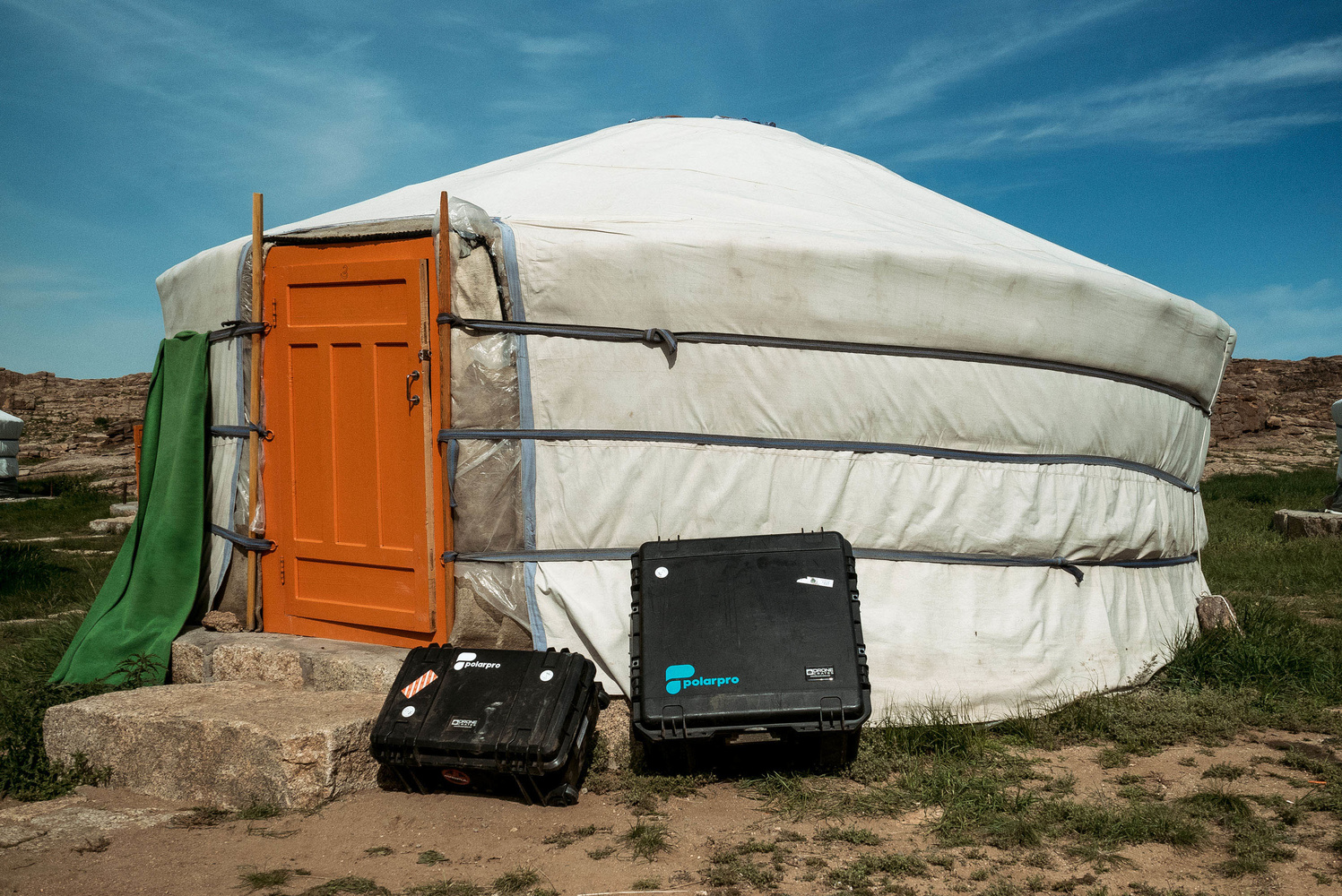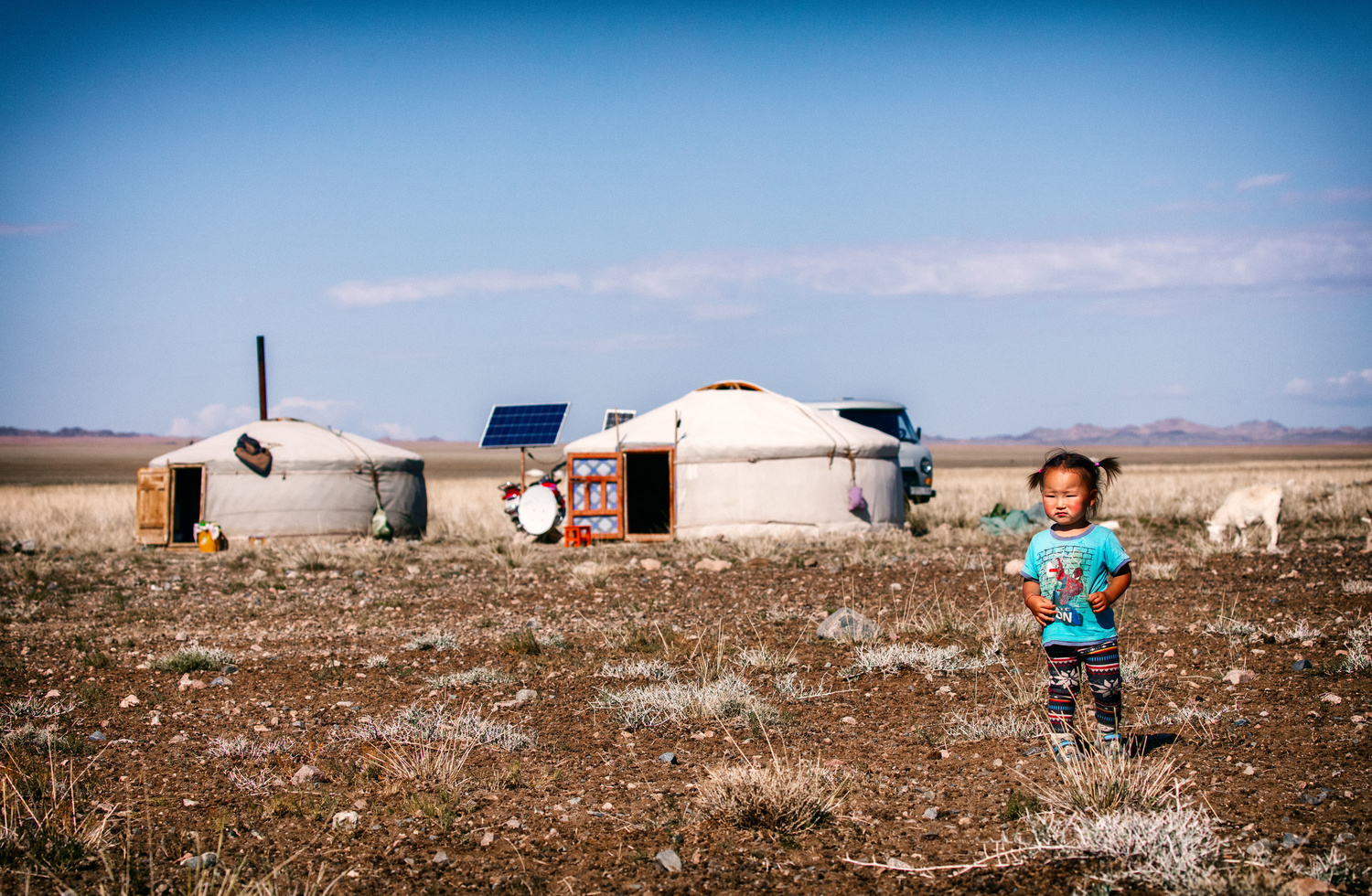San Francisco-based photographer Jeff Colhoun spent the last three summers in Mongolia documenting the activity of various environmental protection projects. The Genghis Khan nation is a huge country with a thin population of three million inhabitants spread out across a vast territory. The remoteness of the place is what made this assignment both appealing and challenging. Here is the story of this photographic journey.
For his third trip to Mongolia, Colhoun was filming a documentary about the Rally For Rangers foundation. Their goal is to deliver motorcycles to park rangers in some of the most remote places of the world to increase their effectiveness and overall quality of life. On top of filming a documentary, he had to capture still imagery for public relations and marketing purposes. Typically he had to carry all his bulky equipment to the other side of the world and do a three persons’ job.
The trip started in Ulaanbaatar, Mongolia’s capital city, and ended at the Otgontenger peak which is one of national’s most sacred sites. From a practical standpoint, it meant to travel 1,200 miles off road. This really was a once in a lifetime trip. The expedition could rely on two support vehicles and 10 riders on Yamaha AG200 motorcycles to accomplish this journey. Each rider purchased his motorcycle to donate to the rangers at the end of the trip.


Gears List, Customs, and Weather
Due to travel and weather conditions, Colhoun explained that “the key to this setup was that everything must be waterproof.” He said, “In previous years I’ve had to leave gears outside in the rain at night and this was no different this time. Every night, I would do a backup onto three identical hard drives. One would be in my shoulder bag, one in my pelican, and one in a different support vehicle in my duffel bag. Redundancy with data is imperative.”
It rained every day for at least an hour. Thanks to the rain covers, he could keep his camera protected from the summer showers.
It order to bring all his equipment to Mongolia from San Francisco and leave it under the rain if necessary, he used two Drone Crates cases and a waterproof duffel bags in checked baggage. The Drone Crates contained the DJI Inspire 2 and Phantom 4. He tossed a Mavic in the spare controller slot of the Inspire case. The cameras, laptop, and lenses were stored in a Pelican 1510 case and a Patagonia waterproof shoulder bag.

With all this equipment, you need an ATA Carnet to clear the customs upon arrival in Mongolia and re-entry in the U.S.A. The administrative process is a bit tedious, but he said, “For the amount of equipment on this type of production it is a necessity to avoid costly duty fees or be subject to confiscation. Indeed, right after landing in Ulaanbaatar, I noticed that half of my cases were not on the baggage carousel. Customs had taken them to their office. It was an hour of jumping through hoops to get them released. As you can imagine, the language barrier did not help.”
Here is what he brought to Mongolia.
Drones:
- DJI Inspire 2 with X5S camera as the main drone
- DJI Phantom 4 Pro as a backup and for high altitude flights
- DJI Mavic Pro because of the portability and the convenient portrait photo mode
- iPad Mini and iPad Air 2 for the DJI GO app
Cameras:
- Canon 5DS for all the stills and time-lapse
- Sony a7S II as the main video camera and night photography
- Sony a6300 as a B video camera
- GoPro Hero 5
Lenses:
- Canon 24-70 f/2.8 II for stills and time-lapse
- Canon 70-300 DO for stills
- Canon 17-40 f/4 for landscape stills
- Sigma EF 35 f/1.4, used for interviews
- Metabones Canon EF to Sony adapter
- Rokinon E mount 50mm f/1.5 for interviews
- Rokinon E mount 14m f/2.8 for night photography
- A few Sony kit lenses for a7S II and a6300. These lenses are for video gimbal work. They are light and really not all that bad.
- Helios 58mm anamorphic with Varavon variable ND adapter. This is just a sharp lens with some amazing flares for video.
Audio and accessories:
- Rodelink Wireless Kit
- Rode VideoMic Pro
- Rode Video Compact
- Varavon A7 Zeus cage
- a6300 Smallrig cage
- Zhiyun Crane gimbal
- PolarPro trippler
- Dozens of PolarPro filters both for full size cameras and drones
- Blackmagic Design Video Assist monitor
- MSI laptop

Field Experience
Every day was spent in a 4x4 land cruiser where Colhoun had the entire backseat to himself and his gears. For the aerial part, most of the filming was done with the DJI Inspire 2 drone but from inside a moving car chasing the riders off road. The expedition drove three weeks without seeing a single paved road. He already had some similar experiences with that sort of flying but this time the cars were going at 65 kph on dirt roads. It was a bit more challenging to concentrate on the screen and maintain good framing. The gimbals and drones had to be constantly recalibrated because of the vibrations in the car.
No permit was necessary to operate the drone because the expedition was working in conjunction with the Mongolian Ministry of Environment. One of the requests he received was for an aerial photo of the 13,500 feet Otgontenger peak. However, the team was only able to reach a location at 10,000 feet to launch the drone. Normally a no-go in the western world but with the government's blessing and the nearest aircraft 1,000 miles away it was a non-issue.


Getting interviews daily from the riders was always a challenge but he found that you could loosen them up with a bit of Vodka (a Mongolian staple) and get them talking. According to Colhoun, Mongolians are extremely friendly. “Probably the most welcoming culture I’ve encountered in my work,” he said. The language barrier is very apparent in Mongolia. Especially in the countryside where no one speaks English and the ones that do will just say yes or agree if they don’t understand you.
Charging was also an issue since they were always off range from the power grid. Therefore, he insisted on having a generator on hand to charge all the gears every night and it got used every night. The team members were sleeping in Gers (Ger means home in Mongolian). They are the iconic round yurts that you always see in photos of Mongolia. It was practically a dirt floor with some carpets laid down in spots, and holes as bathroom he said. Hence, it was impossible to lock the gears, but no one was around anyway.
Food was another interesting point. Let’s just say that Mongolia is not known for its gastronomy. Since it was his third trip in this country, he brought a lot of snacks, granola bars, and beef jerky in his bag. Unfortunately, a lot was not enough and his American stash ran out a week before the end of the expedition.
Of course, Colhoun was getting the usual “hey, film this,” “photograph this,” suggestions from the riders and they were thrilled with the drones. “As you can imagine, everyone is a director,” he said. “If I had followed all my client’s directions I would have ended up with 300 hours of drone footage with guys riding motorcycles, a few photos and no actual content for the documentary. It’s a lesson every creative learns and at the end of the day being able to deliver is more important than placating individuals in the field.”
Eventually, the gear performed fine. The sensors were cleaned a few times with swabs but nothing major. Some of the prime lenses didn’t get out of the bag much. Perhaps next year he will dump a few lenses and trade them for more snacks.


Conclusion
Finally, he explained that “with a project like this you are along for the ride.” He said, “Nobody is going to wait for you to get a lens out of the back of the car or swap a memory card. You need to be ready with everything for the day easily accessible. Expect your gear to get scratched, dinged, and dented. Expect you will have a failure and be prepared. Seeing the singing sand dunes, walking up to the sacred lake at Otgontenger mountain, and chasing camels with a drone was great, but my favorite memory was when we came across a family homestead where they were branding their horses. A one of a kind experience and they were more than happy to let me take a few photos.”
You can follow Colhoun's work on his website, Instagram, and Facebook.
Images by Jeff Colhoun and used with permission.







I was born in Siberia, close enough to Mongolia to see some of it as a kid and according to my parents visited Ulaanbaatar (though I don't remember that part), so I always enjoy seeing these sorts of projects there - some gorgeous vast landscapes!
Here's another fun fact... Mongolia has one of the lowest population densities in the world (bottom 5, I believe), which is pretty crazy if you know that it's southern neighbors have the highest population densities... we're talking tens of thousands of times more (parts of China, Singapore)!
Those are some truly gorgeous images! Really interesting to hear about how he traveled back and learned about the gear he needed for the environment each time. That image with the peak among sand dunes shot from 10,000 feet, is literally awe inspiring. How special it is to be able to see and share something that we would otherwise never get to see the likeness of or experience without photographers that are incredible and selfless enough to do nonprofit work. Excited for the documentary to be released, is there any information on that? Also, in the gear list you mentioned rain covers were imperative. What kind of rain covers do you use or do you make your own? Thanks for sharing, awesome article!